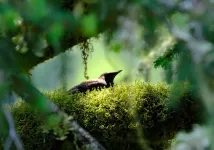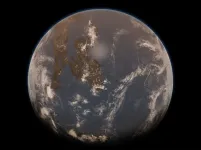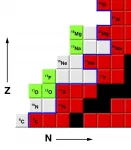INFORMATION:
Other researchers on the project include Melanie Browne with Centro de Ecologia Aplicada del Litoral in Corrientes, Argentina; Wesley M. Hochachka with the Cornell Lab of Ornithology; Dario A. Lijtmaer and Pablo L. Tubaro with Museo Argentino de Ciencias Naturales Bernardino Rivadavia, Buenos Aires, Argentina; Luis Fabio Silveira with Museu de Zoologia da Universidade de Sao Paulo, Sao Paulo, Brazil; and Rebecca J. Safran with CU Boulder.
Endangered songbird challenging assumptions about evolution
By looking at this newly emerged bird, a University of Colorado Boulder-led research team found an 'evolutionary shortcut' for speciation
2021-03-30
(Press-News.org) Not all species may travel the same path to existence, at least according to new findings from the University of Colorado Boulder and collaborators.
This new research, out now in Science, looked at a newly discovered, endangered songbird located only in South America--the Iberá Seedeater--and found that this bird followed a very rare evolutionary path to come into existence at a much faster pace than the grand majority of species.
By comparing this bird to a closely related neighbor (the Tawny-Bellied Seedeater) in the same group (the southern capuchino seedeaters), the researchers determined that genetic shuffling of existing variations, rather than new random mutations, brought this species into existence--and their own behaviors are keeping them apart.
This species is one of only two known examples across the globe to have traveled this path, challenging the typical assumptions of how new species form.
"One of the aspects of this paper that makes it so cool is that we were able to address this question of how the Iberá Seedeaters formed from multiple different perspectives," said Sheela Turbek, a graduate student in ecology and evolutionary biology (EBIO) at University of Colorado Boulder and the study's lead author.
"Not only did we collect on-the-ground data on who mated with one another and the identity of their offspring, but we also generated genomic data to examine how similar these two species are on a genetic level. We then zoomed out further to look at where the Iberá Seedeater fits in the context of the broader capuchino group."
"Many studies will address one of these aspects or questions but not combine all of these different pieces of information into a single study."
The southern capuchino seedeaters are a group of recently evolved songbirds found throughout South America that is branching rapidly, with many of its species in the early stages of evolution. This family is best known for the dramatic variation with the males in terms of songs and plumage color, while the females are largely indistinguishable even to the most familiar researchers.
The Iberá Seedeater, the most recent member of this family, was first discovered in the remote, swampy grasslands of Iberá National Park in northern Argentina by study co-authors Adrián S. Di Giacomo and Cecilia Kopuchian from Centro de Ecología Aplicada del Litoral, Argentina, in 2001, and then described in scientific literature in 2016.
In that national park, though, are six other closely related species of capuchinos, including the Tawny-Bellied Seedeater, that breed closely beside each other. These species, despite occupying the same environment and eating the same food, rarely interbreed.
And so, researchers wondered why--and how--the Iberá Seedeater even came to be.
They explored these questions in two ways: First, they looked at how this new species may have formed by examining the ways in which its DNA differs from the Tawny-Bellied Seedeater, and second, looking at what mechanisms might be preventing it from interbreeding with the other species that occur in the park.
To do that, Turbek went down to Argentina for the breeding season for three years, staying two and a half to three months at a time, searching for and monitoring nests, collecting blood samples from adults and nestlings, and then, in the final year, performed a behavioral experiment to see whether plumage or song played a roll in terms of species recognition.
"The field work involved in collecting the assortative mating and behavioral data is extraordinarily hard, which is why these kinds of datasets rarely exist. This study and publication are a testament to Sheela's skill and hard work in the field," said Scott Taylor, an assistant professor in EBIO at University of Colorado Boulder, an author on the paper and Turbek's advisor.
What they found is that the two birds are closely related genetically, only distinguishable by the genes involved in plumage coloration. As well, they found that the males responded most aggressively to songs and plumage variations aligning with their own species.
This all means that the species could very well reproduce and hybridize--they just choose not to, therefore reinforcing their own reproductive barriers.
On a broader level, though, when comparing the Iberá Seedeater to other capuchino species, the researchers found that the Iberá Seedeater shares genomic variants with other capuchinos in these regions, but the variants have been shuffled to form a unique combination, which, the researchers argue, could be an evolutionary shortcut that most likely underlies much of the diversity among the different subspecies of this family.
"This is a really beautiful story about a process that we have never seen in quite this way before," says co-author Irby Lovette, director of the Fuller Evolutionary Biology Program at the Cornell Lab of Ornithology.
"The classic and most common evolutionary model for new species is the accumulation of genetic mutations when those species are separated by a geographic barrier over perhaps millions of years. But here we found that genetic shuffling can happen quickly and without geographical isolation. It's almost like 'instant speciation.'"
Leonardo Campagna, a research associate at the Cornell Lab of Ornithology and the senior author on the paper, agrees:
"This is the clearest example in birds of how reshuffling of genetic variation can generate a brand-new species."
The only other organism where this type of evolution has been seen, according to Turbek, is a group of fish found in Africa called the Lake Victoria cichlids.
"It's interesting to see this mechanism operating in something as different as birds," Turbek commented.
While this study focused in part on the role of male behaviors, the researchers are very interested in taking it one step further, examining the role that female choice may also play in reproduction.
"There are many more questions that we have to address," Turbek said.
ELSE PRESS RELEASES FROM THIS DATE:
Sounds like home: Murrelets choose breeding locations by eavesdropping on other murrelets
2021-03-30
CORVALLIS, Ore. - Oregon State University researchers broadcast marbled murrelet calls in mature forests and found that the threatened seabirds' choice of breeding locations is strongly influenced by whether they hear other murrelets in the area.
The research by scientists in the OSU College of Forestry and College of Agricultural Sciences is important because the elusive seabird's populations are in decline and recovery may be hindered by there being too few birds around to provide information to each other about where to nest.
Findings were published in Ornithology, the the flagship journal of the American Ornithologists Union.
"The odds that marbled murrelets would ...
An organic material for the next generation of HVAC technologies
2021-03-30
On sultry summer afternoons, heating, ventilation and air conditioning (HVAC) systems provide much-needed relief from the harsh heat and humidity. These systems, which often come with dehumidifiers, are currently not energy efficient, guzzling around 76% of the electricity in commercial and residential buildings.
In a new study, Texas A&M University researchers have described an organic material, called polyimides, that uses less energy to dry air. Furthermore, the researchers said polyimide-based dehumidifiers can bring down the price of HVAC systems, which currently cost thousands of dollars.
"In this study, we took an existing and rather robust polymer and then improved its dehumidification efficiency," said Hae-Kwon Jeong, McFerrin Professor in the Artie McFerrin ...
Study: Insights from two reopened schools during the COVID-19 pandemic
2021-03-30
Since early in the COVID-19 pandemic, parents, teachers, and school administrators have faced difficult questions regarding when and how to safely reopen for in-person learning. During the 2020-2021 fall semester, school districts around the United States navigated their reopening plans -- many opting for exclusively online learning or hybrid models -- with little data on how SARS-CoV-2 spreads among children or how in-person learning would impact transmission in the schools' communities. A new study in The Journal of School Health joins a growing body of evidence that, with appropriate measures, there are ways for schools to safely reopen.
In this study, scientists analyzed data from two large, independent k-12 schools that re-opened for in-person learning ...
Early Earth's hot mantle may have led to Archean 'water world'
2021-03-30
WASHINGTON--A vast global ocean may have covered early Earth during the early Archean eon, 4 to 3.2 billion years ago, a side effect of having a hotter mantle than today, according to new research.
The new findings challenge earlier assumptions that the size of the Earth's global ocean has remained constant over time and offer clues to how its size may have changed throughout geologic time, according to the study's authors.
Most of Earth's surface water exists in the oceans. But there is a second reservoir of water deep in Earth's interior, in the form of hydrogen and oxygen attached to minerals in the mantle.
A new study in AGU Advances, which publishes high-impact, open-access research and commentary across the Earth and space sciences, estimates how much water ...
Apples to apples: neural network uses orchard data to predict fruit quality after storage
2021-03-30
A researcher from Skoltech and his German colleagues have developed a neural network-based classification algorithm that can use data from an apple orchard to predict how well apples will fare in long-term storage. The paper was published in Computers and Electronics in Agriculture.
Before the fruit and vegetables we all like end up on our tables, they have to be stored for quite some time, and during this time they can develop physiological disorders such as flesh browning or superficial scald (brown or black patches on the skin of the fruit). These disorders contribute to the loss of a substantial amount ...
Confronting plastic pollution to protect environmental and public health
2021-03-30
Some 8,300 million metric tons of plastics have been manufactured since production exploded in the 1950s, with more than 75 percent ending up as waste and 15 million metric tons reaching oceans every year. Plastic waste fragments into increasingly smaller but environmentally persistent "microplastics," with potentially harmful effects on the health of people, wildlife and ecosystems. A new collection, "Confronting Plastic Pollution to Protect Environmental and Public Health," is publishing on March 30th, 2021 in the open access journal PLOS Biology that addresses critical scientific challenges in understanding the impacts of microplastics.
The collection features three evidence-based commentaries from ecotoxicology and environmental health ...
Status of greater sage-grouse populations
2021-03-30
RESTON, Va. - Greater sage-grouse populations have declined significantly over the last six decades, with an 80% rangewide decline since 1965 and a nearly 40% decline since 2002, according to a new report by the U.S. Geological Survey. Although the overall trend clearly shows continued population declines over the entire range of the species, rates of change do vary regionally.
The report represents the most comprehensive analysis of greater sage-grouse population trends ever produced and lays out a monitoring framework to assess those trends moving forward. The study can also be used to evaluate the effectiveness of greater sage-grouse conservation efforts and analyze factors that contribute to habitat loss and population change -- all critical ...
Stopping gene-regulating activity of signaling molecule could aid heart failure prevention
2021-03-30
(Philadelphia, PA) - The human heart works under high demand, constantly pumping oxygen-rich blood through the body. When faced with disease, however, fulfilling this demand can become increasingly difficult and harmful. In the case of chronic high blood pressure - a leading cardiovascular disease in the United States - the heart continuously overexerts, resulting in maladaptive growth and, ultimately, severe dysfunction of the heart muscle itself.
Maladaptive growth of the heart, known as cardiac hypertrophy, is brought about in part by activation of G protein-coupled kinase ...
Researchers observe new isotope of fluorine
2021-03-30
Researchers at Washington University in St. Louis reported the first observations of a new form of fluorine, the isotope 13F, described in the journal Physical Review Letters.
They made their discovery as part of an experiment conducted at the National Superconducting Cyclotron Laboratory at Michigan State University (MSU).
Fluorine is the most chemically reactive element on the periodic table. Only one isotope of fluorine occurs naturally, the stable isotope 19F. The new isotope, 13F, is four neutrons removed from the proton drip line, the boundary that delimits the zone beyond which atomic nuclei decay by the emission ...
Synthetic mucus can mimic the real thing
2021-03-30
CAMBRIDGE, MA -- More than just a sign of illness, mucus is a critical part of our body's defenses against disease. Every day, our bodies produce more than a liter of the slippery substance, covering a surface area of more than 400 square meters to trap and disarm microbial invaders.
Mucus is made from mucins -- proteins that are decorated with sugar molecules. Many scientists are trying to create synthetic versions of mucins in hopes of replicating their beneficial traits. In a new study, researchers from MIT have now generated synthetic mucins with a polymer backbone that more accurately mimic the structure and function of naturally occurring mucins. The team also showed that these synthetic mucins could effectively neutralize the bacterial toxin that causes cholera.
The ...
LAST 30 PRESS RELEASES:
Sleeping in on weekends may help boost teens’ mental health
Study: Teens use cellphones for an hour a day at school
After more than two years of war, Palestinian children are hungry, denied education and “like the living dead”
The untold story of life with Prader-Willi syndrome - according to the siblings who live it
How the parasite that ‘gave up sex’ found more hosts – and why its victory won’t last
When is it time to jump? The boiling frog problem of AI use in physics education
Twitter data reveals partisan divide in understanding why pollen season's getting worse
AI is quick but risky for updating old software
Revolutionizing biosecurity: new multi-omics framework to transform invasive species management
From ancient herb to modern medicine: new review unveils the multi-targeted healing potential of Borago officinalis
Building a global scientific community: Biological Diversity Journal announces dual recruitment of Editorial Board and Youth Editorial Board members
Microbes that break down antibiotics help protect ecosystems under drug pollution
Smart biochar that remembers pollutants offers a new way to clean water and recycle biomass
Rice genes matter more than domestication in shaping plant microbiomes
Ticking time bomb: Some farmers report as many as 70 tick encounters over a 6-month period
Turning garden and crop waste into plastics
Scientists discover ‘platypus galaxies’ in the early universe
Seeing thyroid cancer in a new light: when AI meets label-free imaging in the operating room
Neutrophil-to-lymphocyte ratio may aid risk stratification in depressive disorder
2026 Seismological Society of America Annual Meeting
AI-powered ECG analysis offers promising path for early detection of chronic obstructive pulmonary disease, says Mount Sinai researchers
GIMM uncovers flaws in lab-grown heart cells and paves the way for improved treatments
Cracking the evolutionary code of sleep
Medications could help the aging brain cope with surgery, memory impairment
Back pain linked to worse sleep years later in men over 65, according to study
CDC urges ‘shared decision-making’ on some childhood vaccines; many unclear about what that means
New research finds that an ‘equal treatment’ approach to economic opportunity advertising can backfire
Researchers create shape-shifting, self-navigating microparticles
Science army mobilizes to map US soil microbiome
Researchers develop new tools to turn grain crops into biosensors
[Press-News.org] Endangered songbird challenging assumptions about evolutionBy looking at this newly emerged bird, a University of Colorado Boulder-led research team found an 'evolutionary shortcut' for speciation




